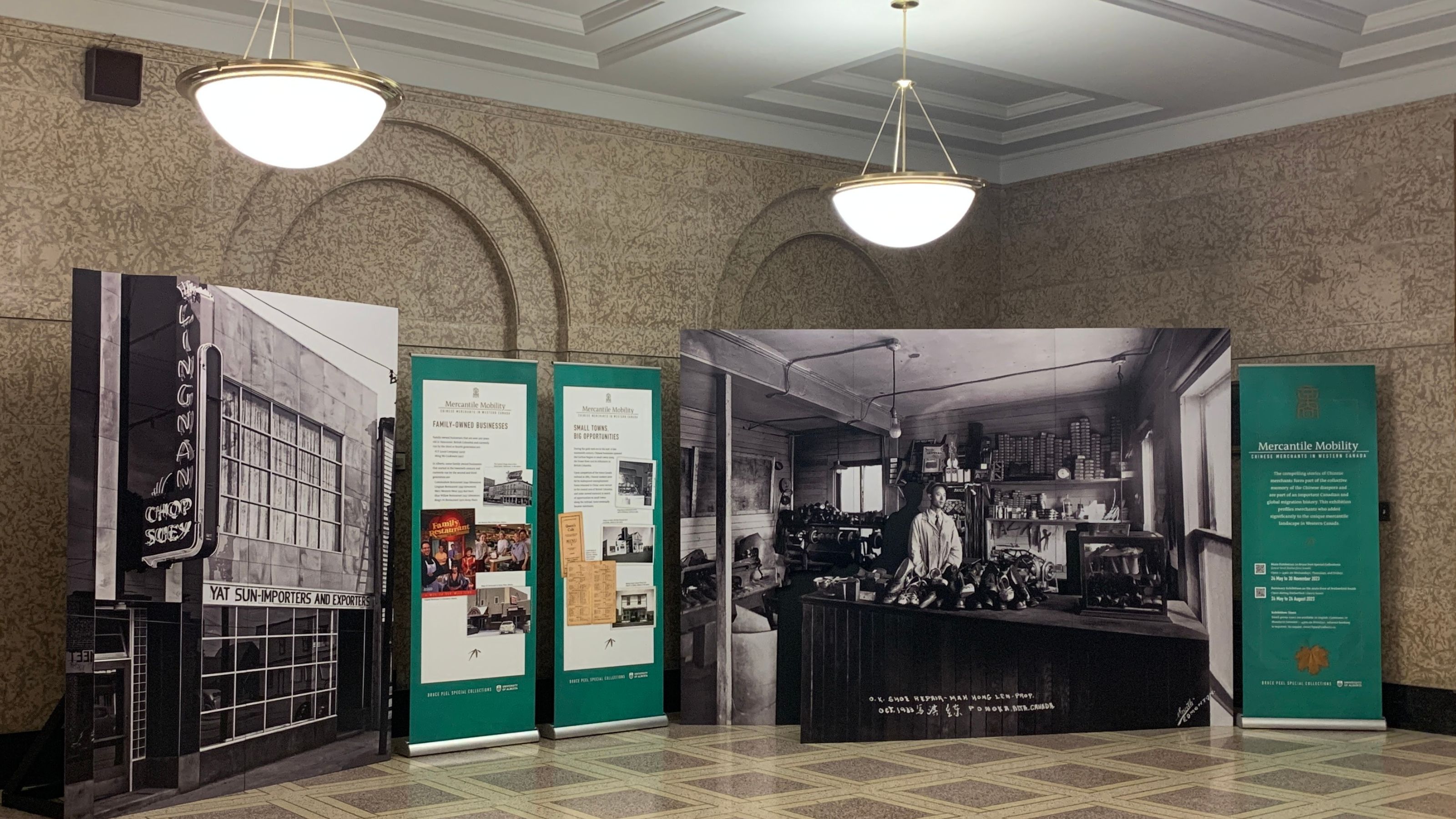Throughout the month of May, the University of Alberta recognizes Asian Heritage Month, which provides an opportunity to deepen our understanding of the challenges and successes – past and present – faced by individuals of Asian heritage and their contributions across Canada.
On May 24, 2023 Bruce Peel Special Collections in the U of A Library opened Mercantile Mobility: Chinese Merchants in Western Canada, an exhibition offering a new perspective on the history of Chinese immigrants in Canada. It explores what happened to Chinese immigrant workers after their contributions to building the Canadian Pacific Railway and profiles several families who went on to become successful merchants across Western Canada.
U of A alumna and guest curator Helen Kwan Yee Cheung returns for her second exhibition with the Peel library following the success of Painted Faces on the Prairies in 2014.
“Helen was such a wonderful curator that I wanted to extend another opportunity to her,” says Robert Desmarais, Head of Special Collections at Bruce Peel. “At Bruce Peel, we're very interested in the stories of Chinese pioneers and settlers in Western Canada, and Chinese immigrants' experiences, and this exhibition really helps to flesh out that story.”
Helen continued collecting archival materials from the community after her first exhibition, nearly 10 years ago. She describes the outset of curating an exhibition an “evolutionary process,” but after finding several materials related to Chinese businesses and immigrants, she and Robert decided to focus the exhibition on Chinese merchants.
“The overall exhibition is the outcome of many years of research,” says Helen, who spent almost nine years interviewing and collecting primary source materials from 14 Chinese families across Western Canada. She says the exhibition, which is a collection of oral history and more than 100 archival materials ranging from immigration documents to family photographs, head tax certificates and other paper ephemera, is about real people.
“The exhibition catalogue is a documentation of history, which if untold, would be lost,” Helen says. “Five of my interviewees have since passed away, so this exhibition has actually become a heritage preservation project.” The catalogue itself is an artifact featuring a metaphorical design motif of the Nan bamboo. "This bamboo seed stayed in the ground for five years before anything happened," Helen says. "The bamboo grows a network of roots underground and in the spring of the sixth year, all of a sudden, the bamboo grows quickly and soars to the sky. I feel this represents Chinese merchants in that they were a very quiet group of people, but they used their clan and kinship relations to build a strong network across Canada."
Nearly all of the exhibition's materials came through Helen’s hard work and the relationships she has built with families who were willing to donate their items to the Peel library. “This is such a collaborative project,” Robert says. “There has been tremendous community involvement.”
“In a wonderful way, Helen is a reflection of these very merchants in her tenacity and the way that she strives for excellence,” Robert says. “She really mirrors the passion that she's writing about in the exhibition.”
Helen says the title of the exhibition, Mercantile Mobility: Chinese Merchants in Western Canada says a lot about the unique features of the exhibition. "Mercantile mobility" refers to the movement and mobility of people, products and money from the mid nineteenth-century to the end of the twentieth-century, which Helen discovered is a time period where very little has been written about Chinese immigrants in Canada.
“Most people talk about immigrants from China and how they came to Canada for the gold mining and railroad construction, but they don't talk about where they went after that,” Helen says.
Through her community-based collection process and in talking to these families, Helen discovered that many merchants and their families moved around in search of survival opportunities. By recounting their stories, Helen has followed their footsteps, tracing their movements through a number of maps in the exhibition’s catalogue. The second half of the exhibition title, "Chinese merchants" refers to how this group managed to create successful businesses in the face of discriminatory legislation, social antipathy and years of separation from their families.
Mercantile Mobility: Chinese Merchants in Western Canada not only honours and promotes awareness of the contributions and achievements made by the Chinese community, but it complements the direction in which the U of A is headed.
“The university’s vision is to build bridges with communities and has an important emphasis on advocating for equity, diversity and inclusion, so this exhibit really helps with promoting the university’s values and mission,” Helen says.
Helen notes the importance of shining a positive light on these experiences, and says she hopes people are inspired by these families’ stories. She also hopes that attendees come away with a better understanding of the history of Chinese immigrants.
"I want people to leave the exhibition knowing that Chinese immigrants didn't just build railroads, but they became merchants and contributed significantly to Canada’s economy."

